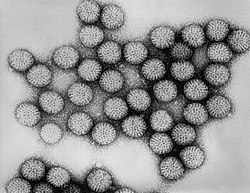| Sedoreoviridae | |
|---|---|
 | |
| Cryo-EM of protein capsid structure of rice dwarf virus (RDV) | |
| Virus classification | |
| (unranked): | Virus |
| Realm: | Riboviria |
| Kingdom: | Orthornavirae |
| Phylum: | Duplornaviricota |
| Class: | Resentoviricetes |
| Order: | Reovirales |
| Family: | Sedoreoviridae |
Sedoreoviridae (sedo = smooth) is a family of the Reovirales order of viruses. [1] Viruses in this family are distinguished by the absence of a turreted protein on the inner capsid to produce a smooth surface. [2]
